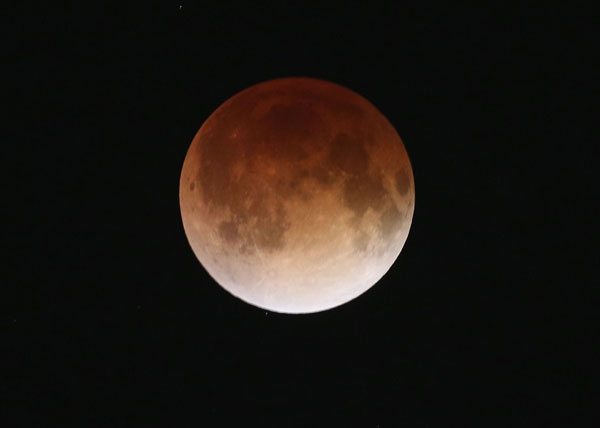Philippines may watch ‘blood moon’ online

The moon is seen during a total lunar eclipse on April 15, 2014 in Miami, Florida. People in most of north and south America should be able to witness this year’s first total lunar eclipse, which will cause a ‘blood moon’ and is the first of four in a rare Tetrad of eclipses over the next two years. AFP
MANILA, Philippines— The lunar eclipse–known in social media as the “blood moon”–may not be visible in the Philippines in its full glory, but Filipino space geeks may watch it online.
A total lunar eclipse, the first since December 2011, will take place Tuesday with the Americas best placed to get a glimpse, Agence France-Presse (AFP) reported.
In the Philippines, the total lunar eclipse, typically seen as a red coloration on the moon, will be visible as a “penumbral eclipse,” or partial shadow, for only about 25 minutes—from the time the moon rises at 6:12 p.m. and when the eclipse ends at 6:37 p.m., the Philippine Daily Inquirer reported quoting the country’s state weather bureau.
In a total lunar eclipse, the moon passes behind the Earth’s shadow, causing the moon to have a red sheen.
In its website, the National Aeronautics and Space Administration (NASA) said the eclipse would begin 2 a.m. EDT (2 p.m. Manila time) and would end at 5 a.m. EDT (5 p.m. Manila time).
Meanwhile, according to the AFP report quoting the US space agency, the first phase – known as a penumbral eclipse – kicked off at 0453 GMT (around 12:53 a.m. EDT or 12:53 p.m. Manila time).
Meanwhile, the total lunar eclipse will start at 0706 GMT (around 3:06 a.m EDT or 3:06 p.m Manila time) and will last until 0824 GMT (4:24 a.m. EDT or 4:24 p.m. Manila time).
The moon will fully emerge from the Earth’s shadow at 1037 GMT (6:37 a.m. EDT or 6:37 p.m. Manila time), the AFP report said.
Netizens may watch a livestream coverage of the eclipse in the NASA website.
Live streaming video by Ustream
While the entire event is visible from North and South America, sky watchers in northern and eastern Europe, eastern Africa, the Middle East and Central Asia will be out of luck, according to NASA.
It’s the first of four consecutive phenomena of this kind this year and 2015, a series astronomers call a tetrad.
The last time a tetrad took place was in 2003-2004, with the next predicted for 2032-2033. In total, the 21st century will see eight tetrads.
The year’s second total lunar eclipse will take place on October 8, with the tetrad’s remaining two expected on April 4 and September 28 of 2015.
In some religious circles, this tetrad has particular significance since it coincides with important Jewish holidays – Passover this year and next and the Feast of Tabernacles in October 2014 and September 2015.
For those eager to follow along from their computer screens, NASA will be transmitting real time images of Tuesday’s eclipse, as well as scientific commentary, on its website.
RELATED STORIES
‘Blushing’ moon playing coy to PH stargazers
Lunar eclipse, meteor showers among celestial spectacles this month